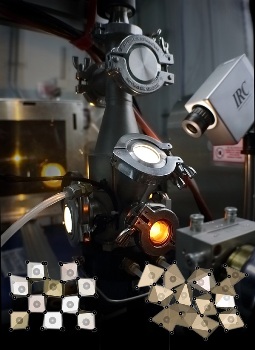Nov 24 2014
Scientists at Stony Brook University have successfully made structure measurements of uranium dioxide (UO2) in molten form.
 Aerodynamic levitation setup at the advanced photon source beamline 6-ID-D. The sample chamber in the foreground is lit from inside by the 3000K laser heated sample inside.
Aerodynamic levitation setup at the advanced photon source beamline 6-ID-D. The sample chamber in the foreground is lit from inside by the 3000K laser heated sample inside.
Nuclear power contributes to global electricity supply. The major fuel component is Uranium dioxide and knowledge about its behavior at extreme temperatures is important to prevent accidents. However, the extreme temperatures required for this study has prevented study of the molten UO2 till now.
In the present study, the researchers used X-rays for studying UO2 structure before and after melting. They discovered that in the structure of UO2, the each uranium atom initially had 8 oxygen atoms surrounding them which went down to 6.7 oxygen atoms, which in turn affected their physical properties.
The researchers combined synchrotron X-rays, sample levitation and laser heating and received measurements of the pair distribution function. Levitation played an important role in this experiment.
The melting point of Uranium dioxide is at around 3140K, and most container materials either melt or can react chemically at this temperature. The researchers levitated the sample aerodynamically on an Argon gas stream and used a 400W continuous CO2 laser to heat the sample.
Levitation prevented contact of the sample with any solid and this ensured purity of the sample. Measurements using synchrotron X-ray diffraction delivered an accurate r UO value of 2.22±0.01Å at 3270K. This value will also help validate other liquid UO2 models. Further, comparatively high U-U mobility has been found in the melt, and other structural models could be tested using this as a reference.
This study has been published in the journal, Science.
References and Further Reading